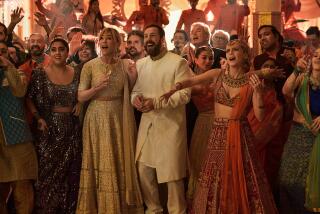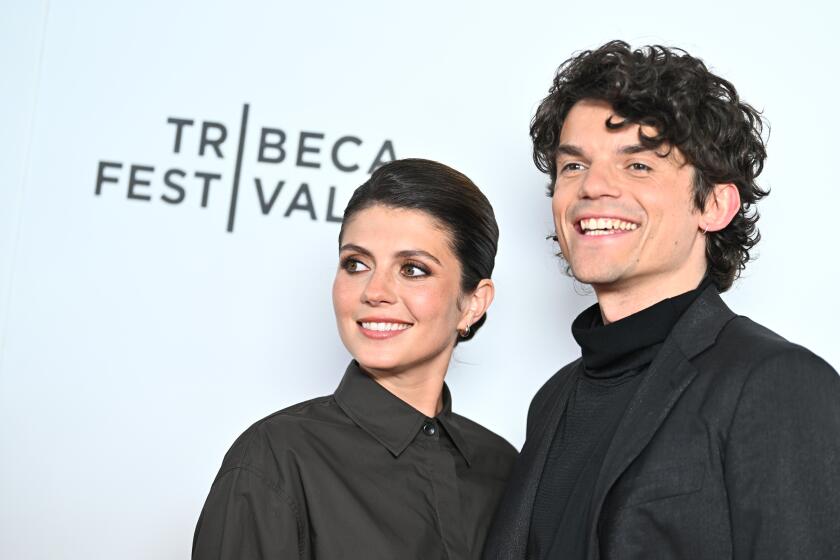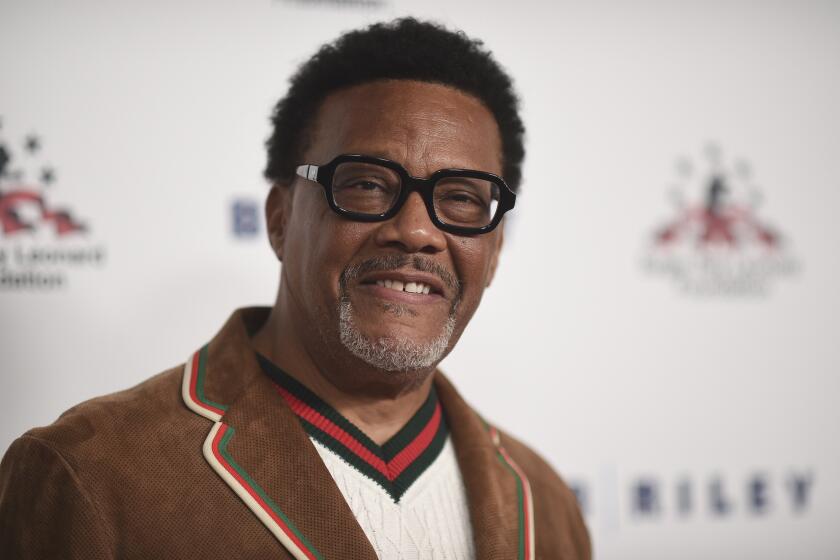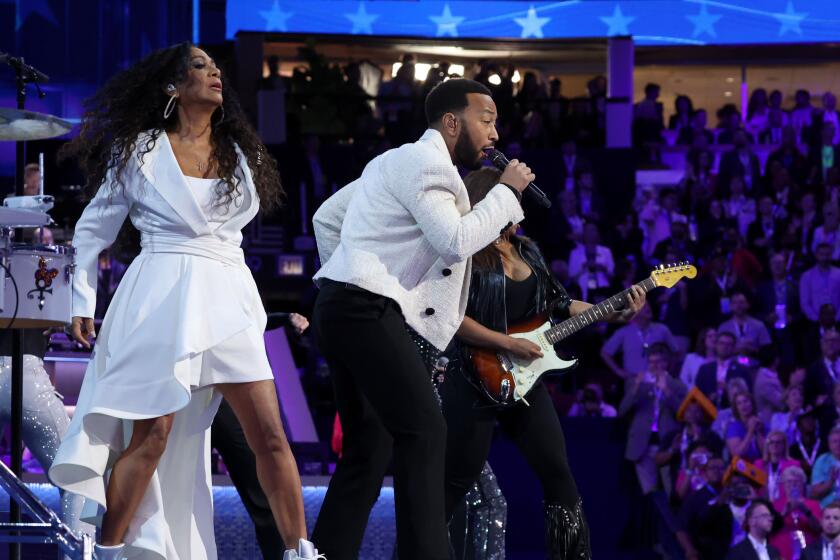Small Screen, Big Picture
Angered and incredulous, Paris Barclay threw the newspaper across the room.
The Emmy-winning director of “NYPD Blue” had just read an article about the lack of ethnic diversity in new series premiering this fall on ABC, CBS, NBC and Fox. What really irked Barclay were quotes in which network executives and producers said they were unable to find enough minority actors suitable for roles in their new comedies and dramas.
“It just infuriated me when I saw that,” said Barclay, who is teaming with producer Steven Bochco on an upcoming CBS drama, “City of Angels,” set in an inner-city hospital. “There’s a great depth in the acting pool, and so few shows are utilizing these people. For our new show, we’re seeing as good actors as we’ve ever seen.”
At a time when the major TV networks have come under fire for presenting a lineup of new prime-time programs strikingly short on minority faces, it’s easily overlooked that a handful of top writer-producers consistently manage to turn out integrated shows. They include Bochco (“NYPD Blue”), David E. Kelley (“Ally McBeal” and “The Practice”), Dick Wolf (“Law & Order”), and Tom Fontana and Barry Levinson, the tandem behind NBC’s just-ended “Homicide: Life on the Street” and HBO’s “Oz.”
If film is a director’s medium, these executive producers are television’s royalty, its most powerful and influential creative forces. That they have successfully put minorities in pivotal roles, in contrast to most new shows and even such current hits as “Frasier” and “Friends,” suggests that organically incorporating minorities into prime time represents a viable, feasible option if the networks are serious about addressing the issue of diversity.
Unlike family-oriented sitcoms, which tend to be more ethnically homogenous, these producers generally base series in work settings, from the hospital corridors of “ER” to the precinct houses of “NYPD Blue” and “Homicide.” Casting with an eye toward diversity, they say, makes sense on multiple levels--from economics to exhibiting an understanding of viewers who live in a multicultural society.
“My feeling is that it’s not forcing people into roles, but showing the fabric of big cities realistically,” Wolf said. “Shows should not be cast with an eye toward ethnic diversity, [but] with an eye toward reality. Series are just more compelling when they’re realistic.”
Television producers “have a responsibility to realistically portray the environment,” “ER” executive producer John Wells said. “You cannot portray a workplace without showing what America looks like.”
Yet despite Wells’ track record on “ER,” the producer has found himself a recent target of criticism for his new NBC drama “The West Wing”--which is set in the White House and initially featured a large ensemble cast without a significant minority character--a prime example of the lack of diversity in the new fall lineup.
“We’ve taken some knocks for that, and rightly so,” said Wells. “We agonized over this at the time of casting, and we’re still agonizing over it. It sounds feeble, but we’re very concerned about it.” Though there was a consensus among NBC and the producers as to which actors to cast, Wells said, “that doesn’t excuse us for not doing a better job.” The producer has cast a racially diverse ensemble in another new NBC series, “Third Watch,” about late-night emergency personnel.
The new crop of nearly all-white shows, suggested Bochco, is as much a result of inertia as anything else. The writers and producers interviewed paint a picture of TV decision-makers who simply haven’t raised diversity--inclusion or exclusion--as an issue.
“I don’t think most networks and most studios and most producers think in terms of diversity,” Bochco said. “I would be loath to say it’s a neglect born of a specific bias, but I do believe it’s because of a certain laziness.”
Joss Whedon’s approach is typical. All the regular characters of “Buffy the Vampire Slayer,” the popular WB network series he created and produces, are white. When it comes to casting, he describes his primary focus as getting the best person for the job, although he added that he has at times purposely avoided casting minorities as villains.
“[Diversity is] not a huge concern for us,” he said. “If the WB came down and said, ‘Try to mix it up more,’ we’d listen to that.”
Although networks are now taking steps to add minorities to several shows--spurred in part by criticism from various quarters, including the press and the NAACP--a climate of indifference does little to foster truly creative and visionary casting, said James McDaniel, who plays Lt. Arthur Fancy on “NYPD Blue.”
“You can look at any story on television and say, ‘This is fantasy,’ ” McDaniel said. “The story and characters can go into any direction that the human mind will allow it to go. Maybe the decision-makers’ concept of ‘the best person for the job’ needs to be expanded upon.”
That’s what Fontana and Levinson did when casting the gritty “Homicide.” Seeking the Baltimore homicide squad’s gruff Italian lieutenant, they wound up hiring a black actor, Yaphet Kotto. They decided to keep him Italian anyway, making that twist a part of the character.
“The key to ‘Homicide’ was we totally cast the best actors that we found,” Fontana said of the series, whose principal cast featured five people of color in its final season. “I think the key for Barry and I, at least, is to never allow our preconceptions when we write it to overwhelm the talent that comes into the room.”
Some producers say they have made a conscious effort, even before the recent focus on diversity, to include minority characters. Glenn Gordon Caron, executive producer of “Moonlighting,” chose to write in an African American in a key supporting role in his new CBS drama “Now and Again.” Dave Hackel, executive producer of CBS’ Ted Danson comedy “Becker,” has also put a premium on diversity.
“When I see a show set in New York and there’s nothing but white faces, that just doesn’t seem real to me,” Hackel said. “In the case of our show, diversity helps us tell the stories we’re relating.”
Rick Berman, executive producer of the “Star Trek”-themed series “Voyager,” “The Next Generation” and “Deep Space Nine,” said multiculturalism was a mandate of “Star Trek” creator Gene Roddenberry, who broke ground in that regard when he introduced the original Enterprise crew in 1966.
“When I first came into this franchise 12 years ago, I knew I was getting involved with something that was based on a vision of the future that had cultural diversity as a tent pole,” Berman said. “Carrying on in that tradition was a natural progression for me.”
More often, diversity on prime time has been left to happenstance.
“It’s very rare that you see people of different races [audition] for the same part,” acknowledged one former studio chief who declined to be identified. “You tend to see three people who all look alike, since the writer has an idea in mind of what the character should be.”
Sharon Jensen, executive director of the New York-based Non-Traditional Casting Project, believes the problem runs much deeper than that and must be dealt with in a proactive way.
“It’s systemic. You can’t look at one part of it without looking at all of it: what stories are chosen, and who the decision-makers are,” said Jensen, whose group claims to have made steady progress integrating Broadway productions and hopes to achieve the same in TV and movies. “Extra effort has to be taken.”
Two years ago, NBC decided to take that sort of action. The network began requiring each new show to include at least one minority in its cast. Then-entertainment division chief Warren Littlefield, who was behind the initiative, says now he was tired of “having to stand up [in front of TV critics] and defend something that I couldn’t ultimately defend.” According to Littlefield, the reaction was mixed.
“Some producers felt it was inappropriate, that the characters didn’t belong,” he recalled. “Others said, ‘Yes, we’ll step up.’ It was really a Band-Aid. What you have to do is go deeper in the process, when the shows are being conceptualized. The antenna has to be up at all those phases.”
Concerns About Jobs Behind the Camera
A key part of that would entail bringing more minorities into the creative process behind the camera, integrating writing staffs as well as executive suites. While some studios operate programs to develop and recruit minority writers, the overwhelming majority of senior “show runners” are white, and minorities say they have difficulty being considered for writing positions on “mainstream” programs.
“If [a series is written by] a bunch of white people, that Hispanic character is going to be a white person’s vision of what a Hispanic is,” noted Karen Taussig, a talent manager who has represented many minority comics.
That is not to say producers--even powerful ones--have carte blanche to fill their shows with minority actors. It falls to the networks to ultimately choose what they want to buy. And this year, networks bought shows conceived and written in the image of the mostly white, youth-oriented dramas such as the WB’s “Dawson’s Creek” and “Felicity,” which have proven they can deliver the young, white viewers advertisers want.
“We really are now in the age of narrowcasting,” said Wells. “There’s very few places where there’s broadcasting. The networks are not thinking about getting more people into the tent; they are going after a certain audience, of a particular age and class.”
D.L. Hughley, who stars in and co-created ABC’s comedy “The Hughleys,” one of the few shows on a major network constructed around an African American lead, agreed. “The people who run the networks and the studios are functioning in a world that doesn’t exist anymore,” said Hughley. “All they care about is going after the 18- to 49-year-old white male, and they’re building all their programming around them.”
And Then: How to Keep the Programs on the Air
The networks’ economic drive to pull in a white audience--the dominant group in sheer numbers, currently representing more than 70% of available TV viewers--is never more sharply felt than in the development of multiethnic dramas. Even the most successful producers face an uphill battle getting--and keeping--a drama on the air if the cast is primarily made up of minority actors.
What success there has been in getting viewers to cross over and watch shows with ethnic casts and stories has historically come with sitcoms, from “The Jeffersons” in the 1970s to “The Hughleys” today. Dramas, however, have an abysmal record. Some of the dramas featuring African American leads in recent years include “Under One Roof,” a 1994 series about a middle-class black family living in suburban Seattle, starring James Earl Jones, and “413 Hope St.,” a Fox show about a youth center introduced in 1997. Both lasted only a few months.
“The great sadness for me is that whenever [networks] do a black hour drama, it’s always heralded as a ‘black hour drama,’ which puts an onus on it immediately,” Fontana said. “It becomes ‘important.’ It doesn’t feel like entertainment. . . . What happened with ‘Homicide’ is that it just happened, and we never talked about it.”
Bochco and Barclay hope “City of Angels,” which stars “L.A. Law’s” Blair Underwood, will be able to break that pattern. The producers expect marketing efforts for the show, which debuts on CBS midseason, will focus on the program’s drama, not its racial composition. And the network will no doubt play heavily on Bochco’s long history of creating mainstream hits such as “Hill Street Blues” and “L.A. Law.”
Fontana, at least, sees the current glut of shows featuring youthful white ensembles as merely a temporary setback to diversity--more a commentary on the TV industry’s tendency to clone perceived successes than anything else.
“It’s a patch that we will pass very quickly,” he said. “It’s going to last a season or two at the most. It’s like everything else: One thing works, and they try to imitate it 16 ways, and they all fail.”
More to Read
The complete guide to home viewing
Get Screen Gab for everything about the TV shows and streaming movies everyone’s talking about.
You may occasionally receive promotional content from the Los Angeles Times.







